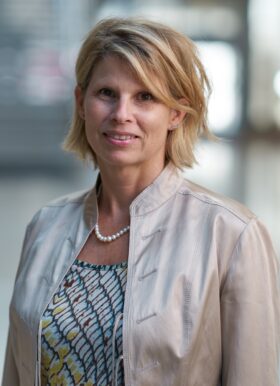
Valeria Cavalli, PhD
Robert E. and Louise F. Dunn Professor of Biomedical Research
- Phone: 314-362-3540
- Email: cavalli@nospam.wustl.edu
Cavalli Lab | Google Scholar Profile | Neurotree
Research
Permanent disabilities following central nervous system (CNS) injuries result from the failure of injured axons to regenerate and re-build functional connections. The poor regenerative capacity of mature CNS neurons remains a major problem in neurobiology and an unmet medical need. In contrast, axon regeneration and partial functional recovery can occur in injured peripheral nerves, providing an opportunity to identify the molecular and cellular mechanisms that control axon repair.
Research in the Cavalli laboratory focuses on elucidating the principles and mechanisms by which peripheral sensory neurons with cell body in dorsal root ganglia regenerate. The lab focusses on understanding how the epigenetic and transcriptional changes elicited in injured sensory neurons promote axon regeneration. The lab also study how satellite glial cells, which envelop the neuronal soma participate in the repair process. The lab is also interested in understanding how immune cells influence neurons and satellite glial cells responses to injury.
A broader understanding of the multi-cellular mechanisms associated with nerve repair may lead to strategies to improve recovery after nervous system injuries. The laboratory use a multifaceted approach in the mouse model system with the goal to manipulate novel pathways the lab discover to improve regeneration in the injured CNS, such as after optic nerve injury or spinal cord injury. The lab also uses human tissue to determine if findings in the mouse model system are relevant to the physiology of human neurons and glia.
Selected publications
- Avraham O, Fend R, Ewan EE, Rustenhoven J, Zhao G, Cavalli C. Profiling sensory neuron microenvironment after peripheral and central axon injury reveals key pathways for neural repair. eLife. September 29, 2021; 10:e68457 doi: 10.7554/eLife.68457
- Spears LD, Adak S, Dong G, Wei X, Spyropoulos G, Zhang Q, Yin L, Feng C, Hu D, Lodhi IJ, Hsu F-F, Rajagopal R, Noguchi KK, Halabi CM, Brier L, Bice AR, Lananna BV, Musiek ES, Avraham O, Cavalli V, Holth JK, Holtzman DM, Wozniak DF, Culver JP, Semenkovich CF. Endothelial ether lipids link the vasculature to blood pressure, behavior, and neurodegeneration. J Lipid Res. Apr 21, 2021; 62:100079. doi: 10.1016/j.jlr.2021.100079. Online ahead of print.
- Ewan EE, Avraham O, Carlin D, Goncalves TM, Zhao G, Cavalli, V. Ascending dorsal column sensory neurons respond to spinal cord injury and downregulate genes related to lipid metabolism. Scientific Reports. January 11, 2021; 11(1):374.
- Avraham O, Deng PY, Jones A, Kuruvilla R, Semenkovich CF, Klyachko VA, Cavalli V. Satellite glial cells promote regenerative growth in sensory neurons. Nature Communications, Sep 29, 2020; 11(1):4891.
Department of Neuroscience featured publication - Carlin D, Halevi A, Ewan EE, Moore A Cavalli V. Nociceptor deletion of Tsc2 enhances axon regeneration by inducing a conditioning injury response in dorsal root ganglia. eNeuro. Jun 25, 2020; 6(3). pii: ENEURO.0168-19.2019.
- Pita Thomas W, Mahar M, Joshi A, Gan D, Cavalli V. HDAC5 promotes optic nerve regeneration in retinal ganglion cells. Exp Neurology. 2019; 317:271-283.
- Mahar M, Cavalli V. Intrinsic mechanisms of neuronal axon regeneration. Nature Reviews Neuroscience. 2018; 19(6):323-337.
- Oh YM, Mahar M, Ewan E, Leahy K, Zhao G, Cavalli V. Epigenetic regulator UHRF1 inactivates REST and growth suppressor gene expression via DNA methylation to promote axon regeneration. PNAS. 2018; 115(52):E12417-E12426.
- Cho Y, Shin JE, Ewan EE, Oh YM, Pita-Thomas W, Cavalli V. Activating injury-responsive genes with hypoxia enhances axon regeneration through neuronal HIF-1α. Neuron. 2015; 18:720-34.
- Cho Y, Park D, Cavalli V. Filamin A is required in injured axons for HDAC5 activity and axon regeneration. J Biol Chem. 2015; 290(37):22759-70.
- Watt D, Dixit R, Cavalli V. JIP3 activates kinesin-1 motility to promote axon elongation. J Biol Chem. 2015; 290(25):15512-25.
- Song W, Cho Y, Watt D, Cavalli, V. Tubulin-tyrosine ligase (TTL)-mediated increase in tyrosinated α-tubulin in injured axons is required for retrograde injury signaling and axon regeneration. J Biol Chem. 2015; 290(23):14765-75.
- Cho Y and Cavalli V. HDAC signaling in neuronal development and regeneration. Curr Opin Neurobiol. 2014; 27:188-126.
- Cho Y, Sloutsky R, Naegle KM and Cavalli V. Injury-induced HDAC5 nuclear export is essential for axon regeneration. Cell. 2013; 155:894-908.
Selected by Faculty of 1000. Highlighted article: Editor’s Choice Science Signaling, Nature Reviews in Neuroscience, and The Scientist. - Shin JE, Cho Y, Beirowski B, Milbrandt J, Cavalli V, DiAntonio A. Dual leucine zipper kinase is required for retrograde injury signaling and axonal regeneration. Neuron. 2012; 74:1015-1022. Highlighted article: Nix P, Bastiani M. Neuron. 2012; 74(6):961-963.`
See a complete list of Dr. Cavalli’s publications on PubMed.
Education
1987-1992 BS and Master in Biochemistry, University of Geneva Switzerland
1991-1994 Predoctoral Research Student, Department of Biological Sciences, University of Rome “La Sapienza” Italy. Advisor Prof. M. Brunori
1994-1995 Predoctoral Research Student, Department of Pharmacology, Biozentrum, Basel, Switzerland. Advisor Prof. M.A Ruegg
1995-2000 PhD Student, Department of Biochemistry, University of Geneva, Switzerland. Thesis advisor Prof. J. Gruenberg
Selected honors
2021 Named the Robert E. and Louis F. Dunn Professor of Biomedical Research
2020 Research Program Award (R35)
2019 Jack Griffin Plenary Lecture, Peripheral Nerve Society (PNS) Annual meeting
2019 Stein Innovation Award, Research to Prevent Blindness
2017 Visiting Faculty Program Fellowship, Weizmann Institute of Science
2014 Distinguished Investigator Award, Washington University School of Medicine
2005 Keystone Symposia Scholarship
2004 CMM Department Retreat, UCSD – Excellence award for outstanding accomplishment in research
2003 International Campaign for Cures of Spinal Cord Injury Paralysis – Outstanding Young Investigator Award
2002 Christopher Reeve Paralysis Foundation – Postdoctoral Fellowship
2001 Swiss National Science Foundation – Postdoctoral Fellowship